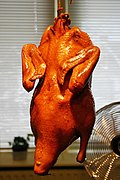Peking duck: Difference between revisions
CSV import Tags: mobile edit mobile web edit |
CSV import |
||
| Line 25: | Line 25: | ||
[[Category:Duck dishes]] | [[Category:Duck dishes]] | ||
{{food-stub}} | {{food-stub}} | ||
<gallery> | |||
File:Peking_Duck,_2014_(02).jpg|Peking duck | |||
File:Quanjude_Oven.jpg|Quanjude oven | |||
File:Dry_for_5_hours_cropped.jpg|Dry for 5 hours | |||
File:Quanjude_roastduck.JPG|Quanjude roast duck | |||
File:Peking_Duck_1.jpg|Peking duck | |||
File:全聚德烤房.JPG|Quanjude roasting room | |||
File:Carving_up_our_duck.jpg|Carving up our duck | |||
File:Gastronomia_china-Pato_a_la_pekinesa5251.JPG|Peking duck | |||
File:Peking_Duck_4.jpg|Peking duck | |||
File:Peking_Duck.jpg|Peking duck | |||
File:Accompagnement_pour_canard_laqué.JPG|Accompaniment for Peking duck | |||
File:Canard_laqué_pret_a_etre_mangé.JPG|Peking duck ready to be eaten | |||
</gallery> | |||
Latest revision as of 11:43, 18 February 2025
Peking Duck is a famous duck dish from Beijing that has been prepared since the imperial era. The meat is characterized by its thin, crisp skin, with authentic versions of the dish serving mostly the skin and little meat, sliced in front of the diners by the cook. Ducks bred specially for the dish are slaughtered after 65 days and seasoned before being roasted in a closed or hung oven.
History[edit]
The dish, originally named Shāo yāzi (燒鴨子), has a history of over 600 years. According to the Complete Recipes for Dishes and Beverages manual in 1330 by Hu Sihui, an inspector of the imperial kitchen, the Peking Duck was an imperial dish by the Yuan Dynasty (1271–1368). By the Qing Dynasty, it gained popularity among the upper classes and was one of the main dishes on imperial court menus.
Preparation[edit]
The preparation of Peking Duck involves a lengthy process of preparation and cooking. The ducks used are of a specific breed, the White Beijing duck, and they are raised in a free-range environment for the first 45 days of their lives. After this, they are kept in a cage which restricts their movement, to fatten them up.
The ducks are killed after 65 days and air is pumped under the skin to separate the skin from the fat. The duck is then cleaned and hung up to dry in the sun. Once dry, the duck is roasted in an oven, traditionally a hung oven, until it turns shiny and reddish-brown.
Serving[edit]
Peking Duck is traditionally carved in front of the diners and served in three stages. First, the skin is served dipped in sugar and garlic sauce. The meat is then served with steamed pancakes (春餅), spring onions and sweet bean sauce. Several vegetable dishes are provided to accompany the meat, typically cucumber sticks.
In popular culture[edit]
Peking Duck has been referenced in various aspects of popular culture, including movies, television shows, and songs. It is often used as a symbol of Chinese cuisine and culture.
See also[edit]
| Chinese cuisine |
|---|
|
|
| Duck dishes | ||||||
|---|---|---|---|---|---|---|
This duck dishes related article is a stub.
|
-
Peking duck
-
Quanjude oven
-
Dry for 5 hours
-
Quanjude roast duck
-
Peking duck
-
Quanjude roasting room
-
Carving up our duck
-
Peking duck
-
Peking duck
-
Peking duck
-
Accompaniment for Peking duck
-
Peking duck ready to be eaten













